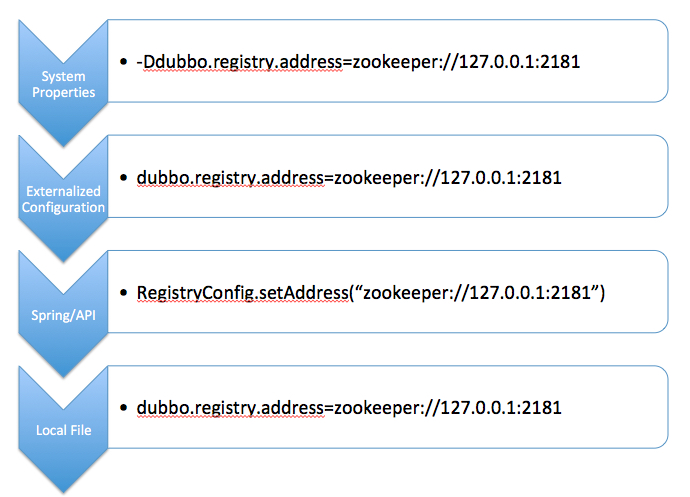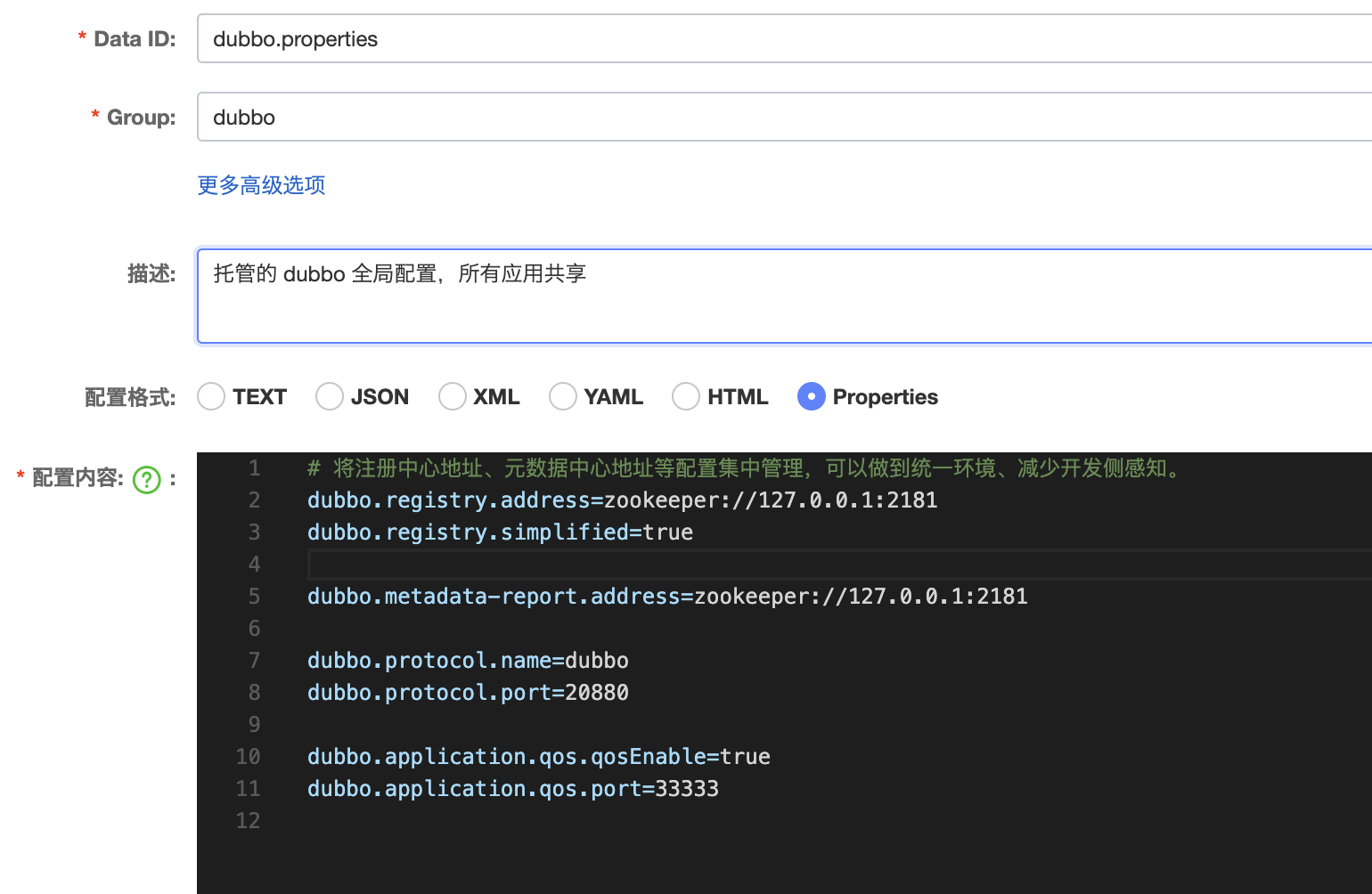- Java锁的逻辑(结合对象头和ObjectMonitor)
- 还在用饼状图?来瞧瞧这些炫酷的百分比可视化新图形(附代码实现)⛵
- 自动注册实体类到EntityFrameworkCore上下文,并适配ABP及ABPVNext
- 基于Sklearn机器学习代码实战
以下是一个 Dubbo 属性配置的例子 dubbo-spring-boot-samples 。
## application.properties
# Spring boot application
spring.application.name=dubbo-externalized-configuration-provider-sample
# Base packages to scan Dubbo Component: @com.alibaba.dubbo.config.annotation.Service
dubbo.scan.base-packages=com.alibaba.boot.dubbo.demo.provider.service
# Dubbo Application
## The default value of dubbo.application.name is ${spring.application.name}
## dubbo.application.name=${spring.application.name}
# Dubbo Protocol
dubbo.protocol.name=dubbo
dubbo.protocol.port=12345
## Dubbo Registry
dubbo.registry.address=N/A
## service default version
dubbo.provider.version=1.0.0
接下来,我们就围绕这个示例,分别从配置格式、配置来源、加载流程三个方面对 Dubbo 配置的工作原理进行分析.
目前Dubbo支持的所有配置都是 .properties 格式的,包括 -D 、 Externalized Configuration 等, .properties 中的所有配置项遵循一种 path-based 的配置格式.
在Spring应用中也可以将属性配置放到 application.yml 中,其树层次结构的方式可读性更好一些.
# 应用级配置(无id)
dubbo.{config-type}.{config-item}={config-item-value}
# 实例级配置(指定id或name)
dubbo.{config-type}s.{config-id}.{config-item}={config-item-value}
dubbo.{config-type}s.{config-name}.{config-item}={config-item-value}
# 服务接口配置
dubbo.service.{interface-name}.{config-item}={config-item-value}
dubbo.reference.{interface-name}.{config-item}={config-item-value}
# 方法配置
dubbo.service.{interface-name}.{method-name}.{config-item}={config-item-value}
dubbo.reference.{interface-name}.{method-name}.{config-item}={config-item-value}
# 方法argument配置
dubbo.reference.{interface-name}.{method-name}.{argument-index}.{config-item}={config-item-value}
应用级配置的格式为:配置类型单数前缀,无id/name.
# 应用级配置(无id)
dubbo.{config-type}.{config-item}={config-item-value}
类似 application 、 monitor 、 metrics 等都属于应用级别组件,因此仅允许配置单个实例;而 protocol 、 registry 等允许配置多个的组件,在仅需要进行单例配置时,可采用此节描述的格式。常见示例如下:
dubbo.application.name=demo-provider
dubbo.application.qos-enable=false
dubbo.registry.address=zookeeper://127.0.0.1:2181
dubbo.protocol.name=dubbo
dubbo.protocol.port=-1
针对某个实例的属性配置需要指定id或者name,其前缀格式为:配置类型复数前缀 + id/name。适用于 protocol 、 registry 等支持多例配置的组件.
# 实例级配置(指定id或name)
dubbo.{config-type}s.{config-id}.{config-item}={config-item-value}
dubbo.{config-type}s.{config-name}.{config-item}={config-item-value}
配置示例:
dubbo.registries.unit1.address=zookeeper://127.0.0.1:2181
dubbo.registries.unit2.address=zookeeper://127.0.0.1:2182
dubbo.protocols.dubbo.name=dubbo
dubbo.protocols.dubbo.port=20880
dubbo.protocols.hessian.name=hessian
dubbo.protocols.hessian.port=8089
dubbo.service.org.apache.dubbo.samples.api.DemoService.timeout=5000
dubbo.reference.org.apache.dubbo.samples.api.DemoService.timeout=6000
方法配置格式
# 方法配置
dubbo.service.{interface-name}.{method-name}.{config-item}={config-item-value}
dubbo.reference.{interface-name}.{method-name}.{config-item}={config-item-value}
# 方法argument配置
dubbo.reference.{interface-name}.{method-name}.{argument-index}.{config-item}={config-item-value}
方法配置示例:
dubbo.reference.org.apache.dubbo.samples.api.DemoService.sayHello.timeout=7000
dubbo.reference.org.apache.dubbo.samples.api.DemoService.sayHello.oninvoke=notifyService.onInvoke
dubbo.reference.org.apache.dubbo.samples.api.DemoService.sayHello.onreturn=notifyService.onReturn
dubbo.reference.org.apache.dubbo.samples.api.DemoService.sayHello.onthrow=notifyService.onThrow
dubbo.reference.org.apache.dubbo.samples.api.DemoService.sayHello.0.callback=true
等价于XML配置:
<dubbo:reference interface="org.apache.dubbo.samples.api.DemoService" >
<dubbo:method name="sayHello" timeout="7000" oninvoke="notifyService.onInvoke"
onreturn="notifyService.onReturn" onthrow="notifyService.onThrow">
<dubbo:argument index="0" callback="true" />
</dubbo:method>
</dubbo:reference>
parameters参数为map对象,支持xxx.parameters=[{key:value},{key:value}]方式进行配置.
dubbo.application.parameters=[{item1:value1},{item2:value2}]
dubbo.reference.org.apache.dubbo.samples.api.DemoService.parameters=[{item3:value3}]
triple协议采用Http2做底层通信协议,允许使用者自定义Http2的 6个settings参数 。
配置格式如下:
# 通知对端header压缩索引表的上限个数
dubbo.rpc.tri.header-table-size=4096
# 启用服务端推送功能
dubbo.rpc.tri.enable-push=false
# 通知对端允许的最大并发流数
dubbo.rpc.tri.max-concurrent-streams=2147483647
# 声明发送端的窗口大小
dubbo.rpc.tri.initial-window-size=1048576
# 设置帧的最大字节数
dubbo.rpc.tri.max-frame-size=32768
# 通知对端header未压缩的最大字节数
dubbo.rpc.tri.max-header-list-size=8192
等价于yml配置:
dubbo:
rpc:
tri:
header-table-size: 4096
enable-push: false
max-concurrent-streams: 2147483647
initial-window-size: 1048576
max-frame-size: 32768
max-header-list-size: 8192
可以将 xml 的 tag 名和属性名组合起来,用 ‘.’ 分隔。每行一个属性.
dubbo.application.name=foo 相当于 <dubbo:application name="foo" /> dubbo.registry.address=10.20.153.10:9090 相当于 <dubbo:registry address="10.20.153.10:9090" /> 如果在 xml 配置中有超过一个的 tag,那么你可以使用 ‘id’ 进行区分。如果你不指定id,它将作用于所有 tag.
dubbo.protocols.rmi.port=1099 相当于 <dubbo:protocol id="rmi" name="rmi" port="1099" /> dubbo.registries.china.address=10.20.153.10:9090 相当于 <dubbo:registry id="china" address="10.20.153.10:9090" /> 复数配置的命名与普通单词变复数的规则相同:
| Config Type | 单数配置 | 复数配置 |
|---|---|---|
| application | dubbo.application.xxx=xxx | dubbo.applications.{id}.xxx=xxx dubbo.applications.{name}.xxx=xxx |
| protocol | dubbo.protocol.xxx=xxx | dubbo.protocols.{id}.xxx=xxx dubbo.protocols.{name}.xxx=xxx |
| module | dubbo.module.xxx=xxx | dubbo.modules.{id}.xxx=xxx dubbo.modules.{name}.xxx=xxx |
| registry | dubbo.registry.xxx=xxx | dubbo.registries.{id}.xxx=xxx |
| monitor | dubbo.monitor.xxx=xxx | dubbo.monitors.{id}.xxx=xxx |
| config-center | dubbo.config-center.xxx=xxx | dubbo.config-centers.{id}.xxx=xxx |
| metadata-report | dubbo.metadata-report.xxx=xxx | dubbo.metadata-reports.{id}.xxx=xxx |
| ssl | dubbo.ssl.xxx=xxx | dubbo.ssls.{id}.xxx=xxx |
| metrics | dubbo.metrics.xxx=xxx | dubbo.metricses.{id}.xxx=xxx |
| provider | dubbo.provider.xxx=xxx | dubbo.providers.{id}.xxx=xxx |
| consumer | dubbo.consumer.xxx=xxx | dubbo.consumers.{id}.xxx=xxx |
| service | dubbo.service.{interfaceName}.xxx=xxx | 无 |
| reference | dubbo.reference.{interfaceName}.xxx=xxx | 无 |
| method | dubbo.service.{interfaceName}.{methodName}.xxx=xxx dubbo.reference.{interfaceName}.{methodName}.xxx=xxx |
无 |
| argument | dubbo.service.{interfaceName}.{methodName}.{arg-index}.xxx=xxx | 无 |
Dubbo 默认支持 6 种配置来源:
关于dubbo.properties属性:
-Ddubbo.properties.file=xxx.properties 。 如果通过多种配置来源指定了相同的配置项,则会出现配置项的互相覆盖,具体覆盖关系和优先级请参考下一小节.
Dubbo 配置加载大概分为两个阶段:

发生属性覆盖可能有两种情况,并且二者可能是会同时发生的:

属性覆盖是指用配置的属性值覆盖config bean实例的属性,类似Spring PropertyOverrideConfigurer 的作用.
Property resource configurer that overrides bean property values in an application context definition. It pushes values from a properties file into bean definitions. Configuration lines are expected to be of the following form
beanName.property=value 。
但与 PropertyOverrideConfigurer 的不同之处是,Dubbo的属性覆盖有多个匹配格式,优先级从高到低依次是:
#1. 指定id的实例级配置
dubbo.{config-type}s.{config-id}.{config-item}={config-item-value}
#2. 指定name的实例级配置
dubbo.{config-type}s.{config-name}.{config-item}={config-item-value}
#3. 应用级配置(单数配置)
dubbo.{config-type}.{config-item}={config-item-value}
属性覆盖处理流程:
按照优先级从高到低依次查找,如果找到此前缀开头的属性,则选定使用这个前缀提取属性,忽略后面的配置.

外部化配置目的之一是实现配置的集中式管理,这部分业界已经有很多成熟的专业配置系统如 Apollo, Nacos 等,Dubbo 所做的主要是保证能配合这些系统正常工作.
外部化配置和其他本地配置在内容和格式上并无区别,可以简单理解为 dubbo.properties 的外部化存储,配置中心更适合将一些公共配置如注册中心、元数据中心配置等抽取以便做集中管理.
# 将注册中心地址、元数据中心地址等配置集中管理,可以做到统一环境、减少开发侧感知。
dubbo.registry.address=zookeeper://127.0.0.1:2181
dubbo.registry.simplified=true
dubbo.metadata-report.address=zookeeper://127.0.0.1:2181
dubbo.protocol.name=dubbo
dubbo.protocol.port=20880
dubbo.application.qos.port=33333
优先级 外部化配置默认较本地配置有更高的优先级,因此这里配置的内容会覆盖本地配置值,关于各配置形式间的 覆盖关系 有单独一章说明.
作用域 外部化配置有全局和应用两个级别,全局配置是所有应用共享的,应用级配置是由每个应用自己维护且只对自身可见的。当前已支持的扩展实现有 Zookeeper、Apollo、Nacos.
<dubbo:config-center address="zookeeper://127.0.0.1:2181"/>

开启外部化配置后,registry、metadata-report、protocol、qos 等全局范围的配置理论上都不再需要在应用中配置,应用开发侧专注业务服务配置,一些全局共享的全局配置转而由运维人员统一配置在远端配置中心.
这样能做到的效果就是,应用只需要关心:
举例来说,每个应用中 Dubbo 相关的配置只有以下内容可能就足够了,其余的都托管给相应环境下的配置中心:
dubbo
application
name: demo
config-center
address: nacos://127.0.0.1:8848
所谓 Dubbo 对配置中心的支持,本质上就是把 .properties 从远程拉取到本地,然后和本地的配置做一次融合。理论上只要 Dubbo 框架能拿到需要的配置就可以正常的启动,它并不关心这些配置是自己加载到的还是应用直接塞给它的,所以Dubbo还提供了以下API,让用户将自己组织好的配置塞给 Dubbo 框架(配置加载的过程是用户要完成的),这样 Dubbo 框架就不再直接和 Apollo 或 Zookeeper 做读取配置交互.
// 应用自行加载配置
Map<String, String> dubboConfigurations = new HashMap<>();
dubboConfigurations.put("dubbo.registry.address", "zookeeper://127.0.0.1:2181");
dubboConfigurations.put("dubbo.registry.simplified", "true");
//将组织好的配置塞给Dubbo框架
ConfigCenterConfig configCenter = new ConfigCenterConfig();
configCenter.setExternalConfig(dubboConfigurations);
欢迎在 https://github.com/apache/dubbo 给 Dubbo Star。 搜索关注官方微信公众号:Apache Dubbo,了解更多业界最新动态,掌握大厂面试必备 Dubbo 技能 。
最后此篇关于一文了解Dubbo3配置工作原理的文章就讲到这里了,如果你想了解更多关于一文了解Dubbo3配置工作原理的内容请搜索CFSDN的文章或继续浏览相关文章,希望大家以后支持我的博客! 。
本文全面深入地探讨了Docker容器通信技术,从基础概念、网络模型、核心组件到实战应用。详细介绍了不同网络模式及其实现,提供了容器通信的技术细节和实用案例,旨在为专业从业者提供深入的技术洞见和实
📒博客首页:崇尚学技术的科班人 🍣今天给大家带来的文章是《Dubbo快速上手 -- 带你了解Dubbo使用、原理》🍣 🍣希望各位小伙伴们能够耐心的读完这篇文章🍣 🙏博主也在学习阶段,如若发
一、写在前面 我们经常使用npm install ,但是你是否思考过它内部的原理是什么? 1、执行npm install 它背后帮助我们完成了什么操作? 2、我们会发现还有一个成为package-lo
Base64 Base64 是什么?是将字节流转换成可打印字符、将可打印字符转换为字节流的一种算法。Base64 使用 64 个可打印字符来表示转换后的数据。 准确的来说,Base64 不算
目录 协程定义 生成器和yield语义 Future类 IOLoop类 coroutine函数装饰器 总结 tornado中的
切片,这是一个在go语言中引入的新的理念。它有一些特征如下: 对数组抽象 数组长度不固定 可追加元素 切片容量可增大 容量大小成片增加 我们先把上面的理念整理在这
文章来源:https://sourl.cn/HpZHvy 引 言 本文主要论述的是“RPC 实现原理”,那么首先明确一个问题什么是 RPC 呢?RPC 是 Remote Procedure Call
源码地址(包含所有与springmvc相关的,静态文件路径设置,request请求入参接受,返回值处理converter设置等等): spring-framework/WebMvcConfigurat
请通过简单的java类向我展示一个依赖注入(inject)原理的小例子虽然我已经了解了spring,但是如果我需要用简单的java类术语来解释它,那么你能通过一个简单的例子向我展示一下吗?提前致谢。
1、背景 我们平常使用手机和电脑上网,需要访问公网上的网络资源,如逛淘宝和刷视频,那么手机和电脑是怎么知道去哪里去拿到这个网络资源来下载到本地的呢? 就比如我去食堂拿吃的,我需要
大家好,我是飞哥! 现在 iptables 这个工具的应用似乎是越来越广了。不仅仅是在传统的防火墙、NAT 等功能出现,在今天流行的的 Docker、Kubernets、Istio 项目中也经
本篇涉及到的所有接口在公开文档中均无,需要下载 GitHub 上的源码,自己创建私有类的文档。 npm run generateDocumentation -- --private yarn gene
我最近在很多代码中注意到人们将硬编码的配置(如端口号等)值放在类/方法的深处,使其难以找到,也无法配置。 这是否违反了 SOLID 原则?如果不是,我是否可以向我的团队成员引用另一个“原则”来说明为什
我是 C#、WPF 和 MVVM 模式的新手。很抱歉这篇很长的帖子,我试图设定我所有的理解点(或不理解点)。 在研究了很多关于 WPF 提供的命令机制和 MVVM 模式的文本之后,我在弄清楚如何使用这
可比较的 jQuery 函数 $.post("/example/handler", {foo: 1, bar: 2}); 将创建一个带有 post 参数 foo=1&bar=2 的请求。鉴于 $htt
如果Django不使用“延迟查询执行”原则,主要问题是什么? q = Entry.objects.filter(headline__startswith="What") q = q.filter(
我今天发现.NET框架在做计算时遵循BODMAS操作顺序。即计算按以下顺序进行: 括号 订单 部门 乘法 添加 减法 但是我四处搜索并找不到任何文档确认 .NET 绝对 遵循此原则,是否有此类文档?如
已结束。此问题不符合 Stack Overflow guidelines .它目前不接受答案。 我们不允许提出有关书籍、工具、软件库等方面的建议的问题。您可以编辑问题,以便用事实和引用来回答它。 关闭
API 回顾 在创建 Viewer 时可以直接指定 影像供给器(ImageryProvider),官方提供了一个非常简单的例子,即离屏例子(搜 offline): new Cesium.Viewer(
As it currently stands, this question is not a good fit for our Q&A format. We expect answers to be

我是一名优秀的程序员,十分优秀!